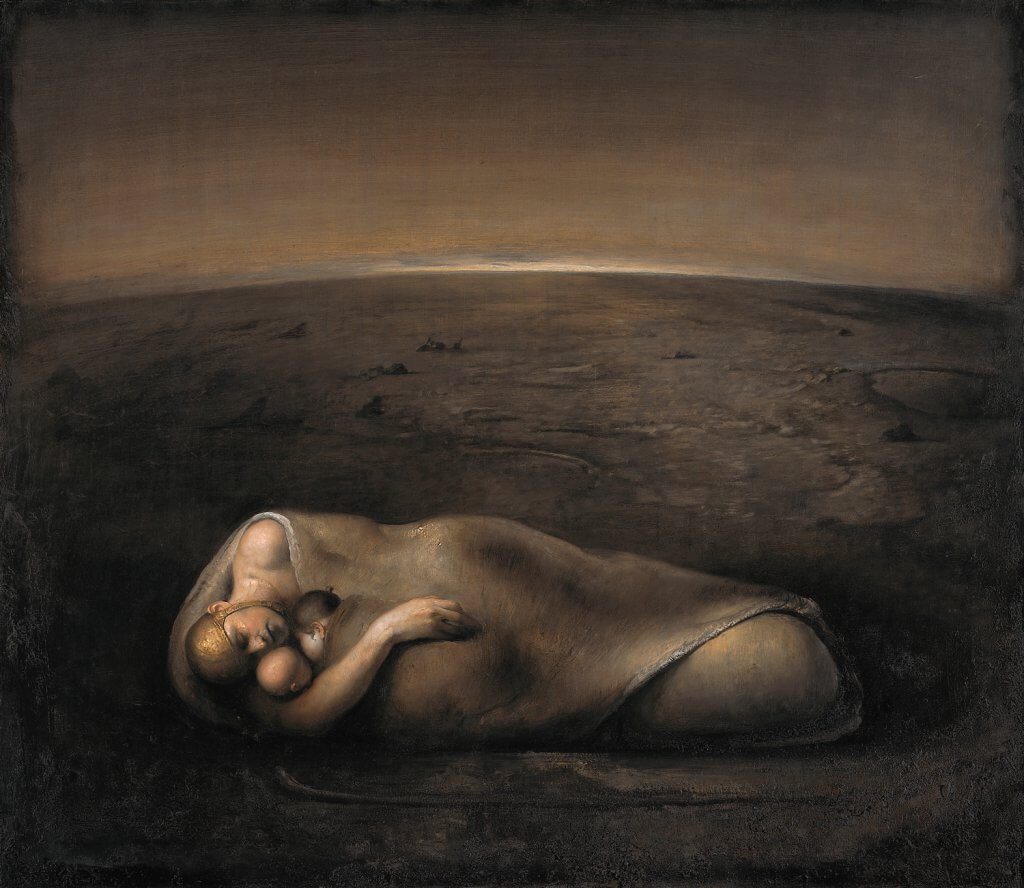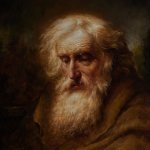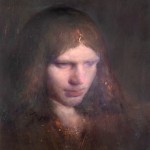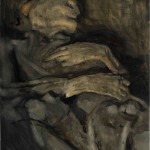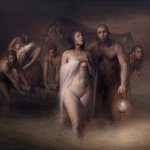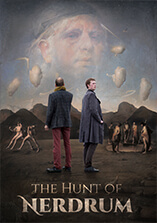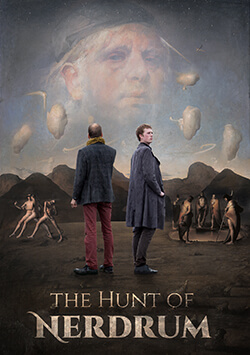News and Articles › Paintings and drawings
If the embodiment of the fundamental idea of our age were to be found in Victorian architecture […] then our age would undoubtedly be called the ‘age of kitsch.’
— Hermann Broch, author
Top list
View the entire list
Only in the last few years I have understood where I am heading in this world. I have begun to grasp the forms of nature. My mission is to clarify life in a way that is a supplement to what was created before. Nature is no longer man’s opponent — it is man’s savior. — Odd Nerdrum, 1987
After a decade of Social Realism in the spirit of Caravaggio, Nerdrum brings his figures into a deserted landscape.
In glowing twilight, timeless figures appear, on the run from civilization and the modern world, to an indigenous society where human beings must survive on their own.
But what caused the sudden transformation in the paintings during the early ’80s?
SPOILER ALERT! This is the third in a series of six articles based on “The Hunt of Odd Nerdrum” (2018) which is available for streaming at vimeo.com/ondemand/oddnerdrum. I advise everyone to watch the documentary before reading this article.
Members of WWK get 25% off any purchase. Send an e-mail to nerdrum.bork@gmail.com for more information.
Members of WWK get 25% off any purchase. Send an e-mail to nerdrum.bork@gmail.com for more information.
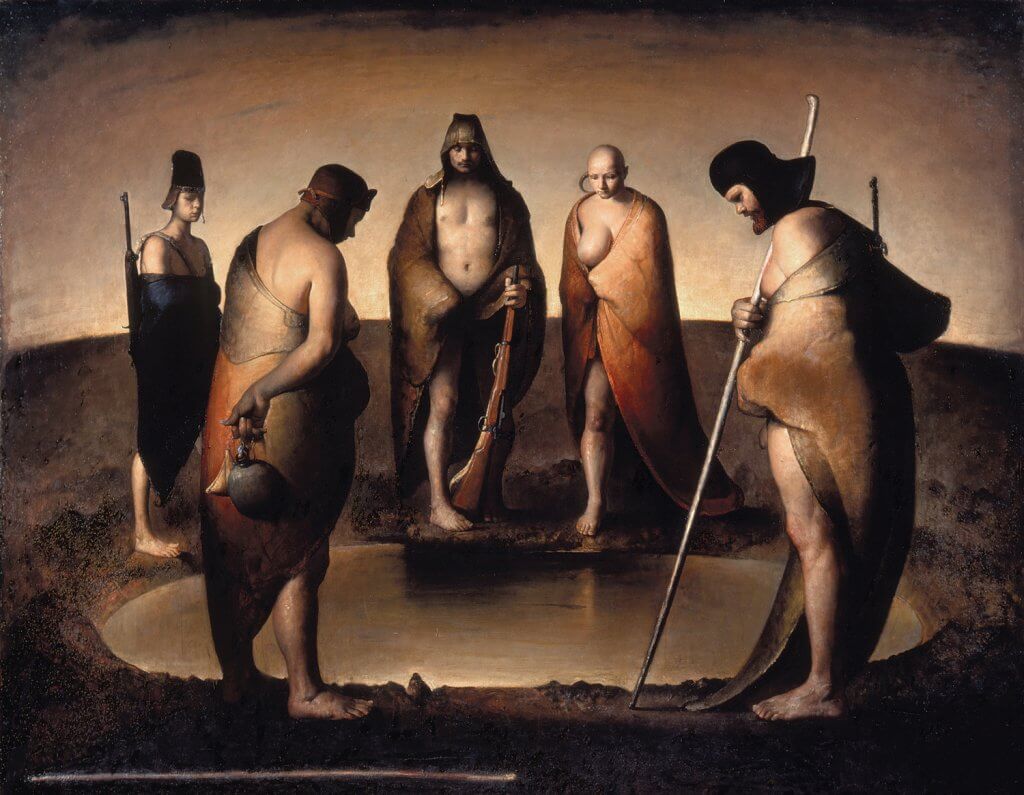
“Five People Around a Waterhole” (1992) by Odd Nerdrum
The Transformation
After creating a series of “twilight” pictures, Nerdrum had reached a crossroads in his life. He had started to work on a large composition called “Palestinian Prisoners” in 1982, but the painting was not even half-way finished when gave up on it. With works such as Twilight (1981), he was abandoning the idea of healing the present day through the classical spirit.
At the time, Käthe Kollwitz came to him in a dream and told him he had to get out of time, and he was fascinated by Rousseau’s idea of bringing man back to his natural state.
“The transition was striking,” Per T. Lundgren recounted in an interview for The Hunt of Odd Nerdrum, “Odd would always extract as much as possible from one particular source. It happened between 1982-83, when he undertook a drastic adjustment to his figuration, the backdrop and the shape of the details; “The Brick” is an example from this period. It seemed like the individuality of each shape was to be rendered with thorough execution.”
Whilst in the process of painting “The Fall” in 1983, Nerdrum’s worldview had changed for good.
Lundgren says that “The Fall” was originally yet another product of Social Realism and that there exists an intimate scene — including a washbasin in the forefront — behind the top layer of the painting.
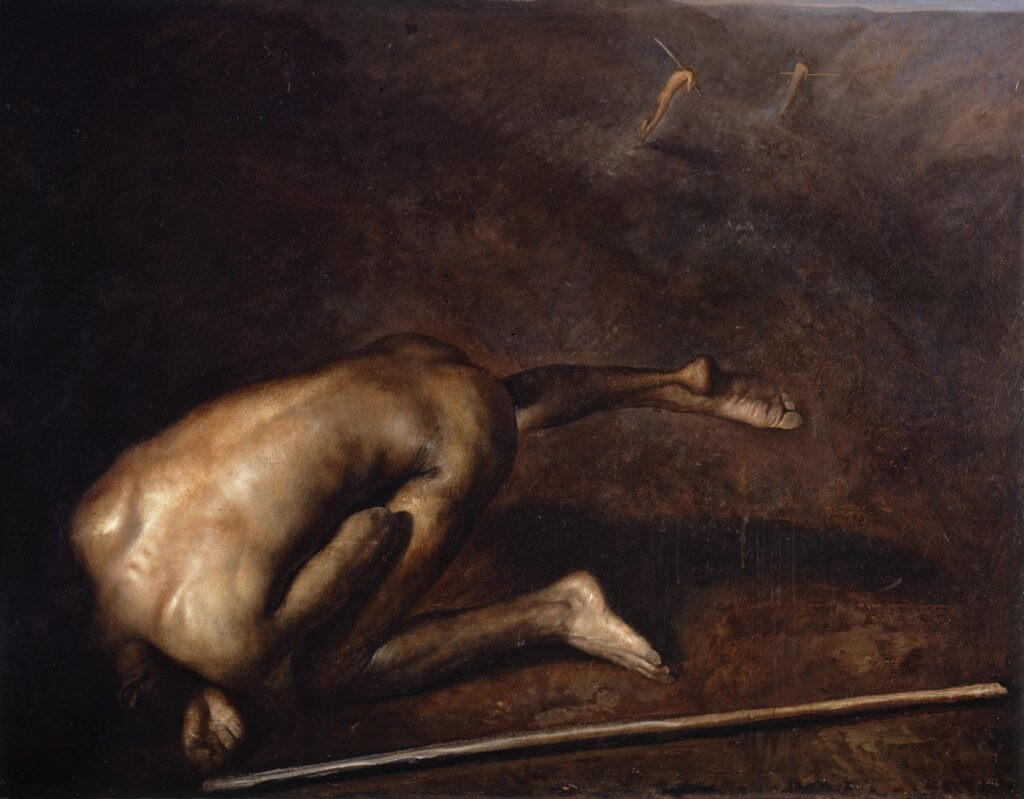
“The Fall” (1983) by Odd Nerdrum
Nerdrum had seen some powerful scenes in Downtown New York and represented this experience in the early version of “The Fall,” which displayed a “frightened and bewildered man, confronted by the modern world,” according to Lundgren. But then something happened:
“Suddenly he could not find any reason for saying: ‘this is a scene from America.’ He saw a sudden need to transpose his imagery to a whole other level, which in short should be ‘timeless.'”
The Icelandic Film Director
Two years later, Nerdrum discovers the first in a series of three viking-movies called When The Raven Flies (1984). The film, which is strongly influenced by Kurosawa’s Yojimbo, is set in the Age of the Sturlungs in Iceland and has a much rougher and realistic appearance compared to other Viking films from that time.
It turns out, what drew Nerdrum to Iceland was not a painter, but an Icelandic film director, who received attention for his exceptional representation of the Middle Ages.
Hrafn Gunnlaugsson’s film becomes a revelation for Nerdrum, who, at the earliest opportunity, travels to Iceland and purchases the props. He also sends a print of one of his self-portraits to the film director and expresses his wish to meet during his trip to Iceland in 1986. But at the time, Gunnlaugsson was in Sweden working on a film project and the meeting first takes place in Oslo, a couple of years later.
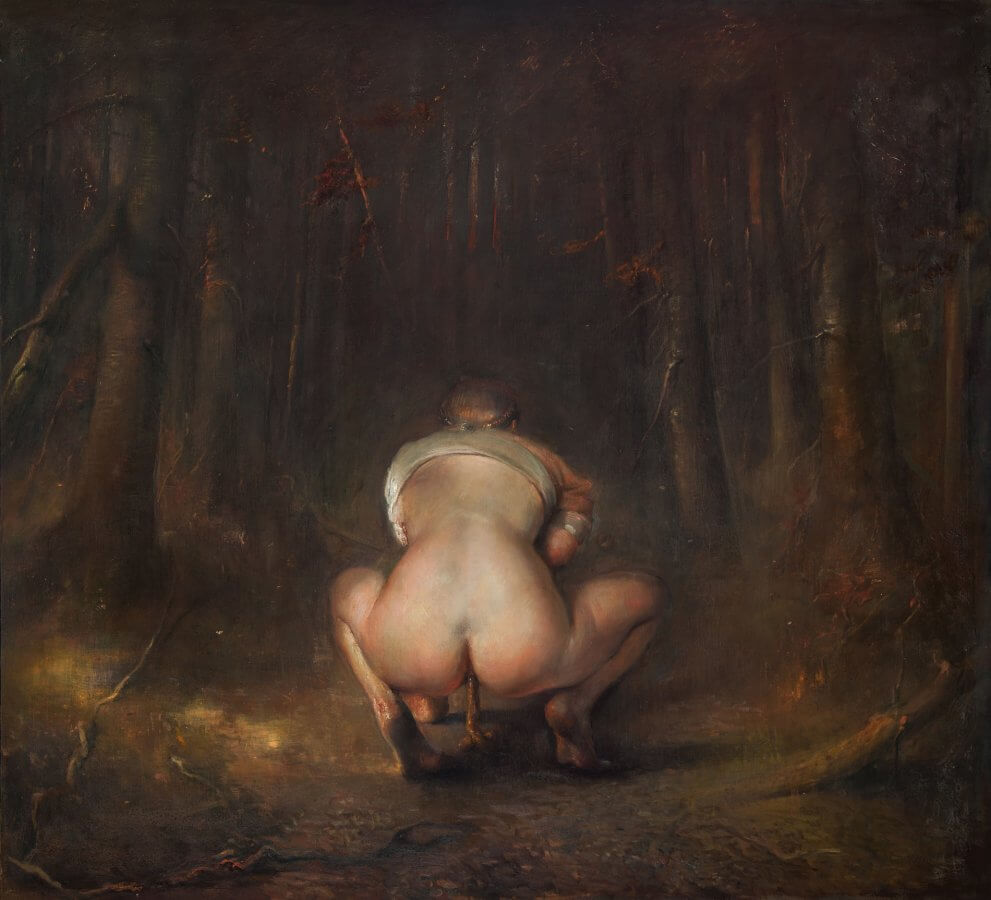
“Twilight” (1981) by Odd Nerdrum
I had seen some of his paintings in the beginning, I didn’t really like them, I was not very interested. But then I meet him by accident on a street in Oslo. And he tells me where he is living and it was just a five minute walk from my hotel. And he invites me to come to his house. I go to his house, and we go to the garage. And there he had a huge painting called “A Woman Shitting in the Woods.”
Life itself is a kind of realism. And life itself is very cruel. Every man goes to the toilet, once a day, he sits down and he shits. Like an animal, you know. Then he cleans, washes his hands, and walks out and he is no more an animal.
Then, I really discovered him. Then I started to connect with his painting and understand what he was doing. — Hrafn Gunnlaugsson, interviewed for The Hunt of Odd Nerdrum
With Gunnlaugsson’s movie props and study trips to Iceland, Nerdrum’s baroque figures moved out into an eternal world of twilight. In the post-apocalyptic world, the forgeries that characterize civilized society, are non-existent. Man stands unprotected in the lawless landscape and lives in covenant with the elements. Everything surrounding them is nameless and has to be redefined.
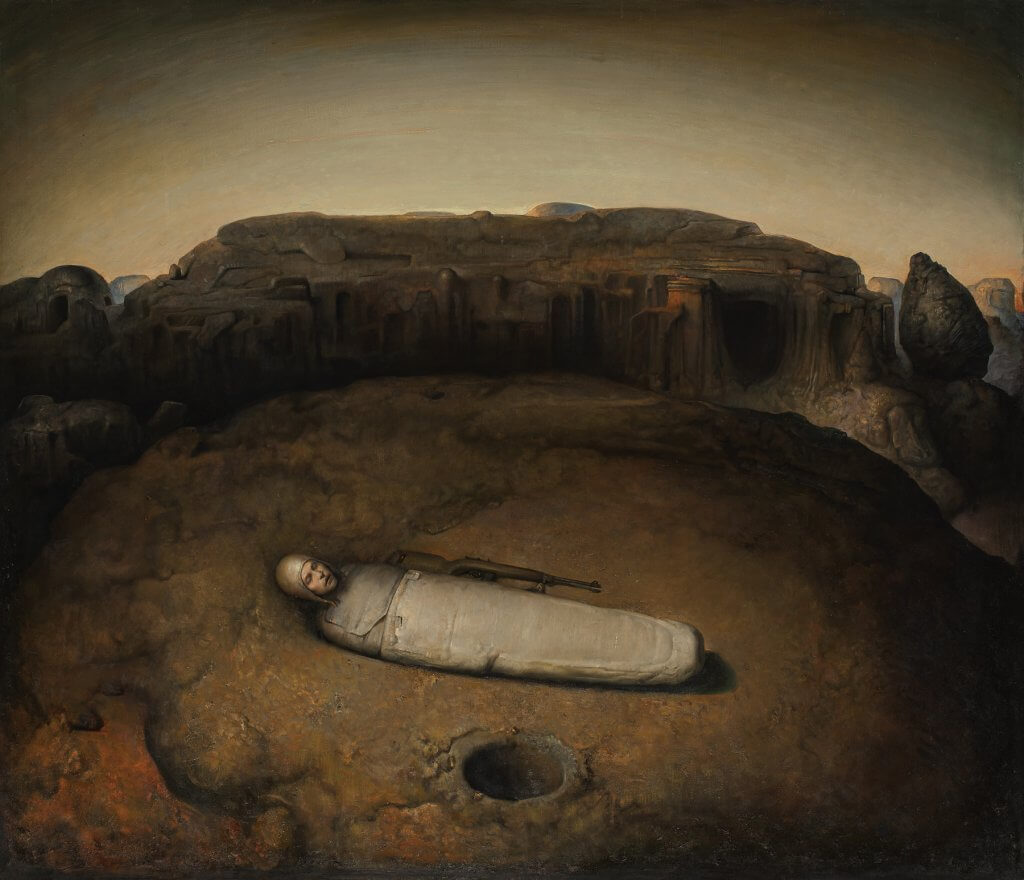
“Sleeping Courier” (1985) by Odd Nerdrum. His first motif from Iceland.
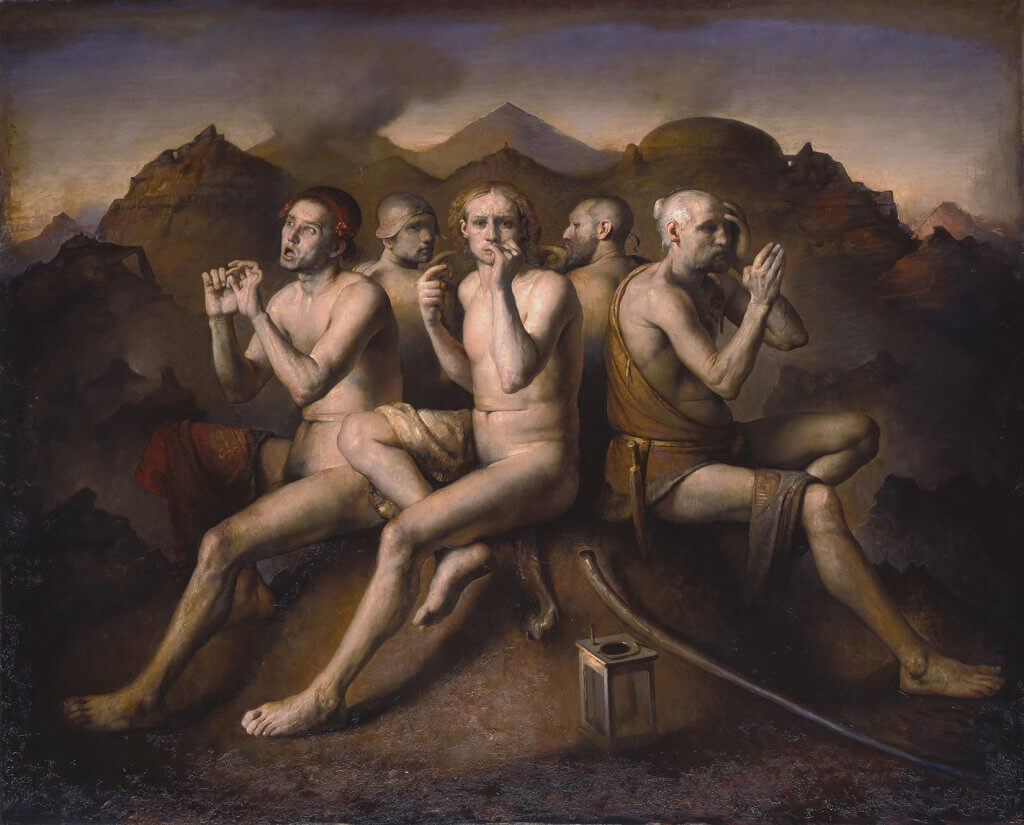
“Five Namegivers” (1994) by Odd Nerdrum
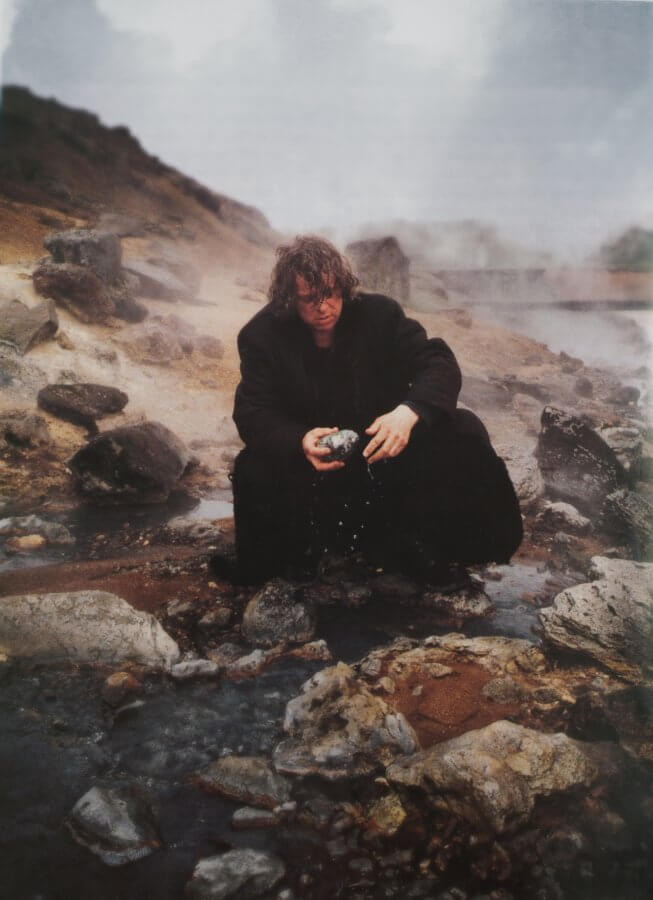
Odd Nerdrum, studying the landscape of Krýsuvík on one of his trips to Iceland.
During the mid ’80s, Nerdrum visits places such as Heiðmörk and Krýsuvík. “Sleeping Courier,” (above) was Nerdrum’s first painting based on the Icelandic landscape, and reveals a representation of the rock formations at Gullfoss in the background.
Nerdrum has explained that he had used a similar landscape to that of Iceland before, but that he had visit the volcanic island to confirm its existence.
The Icelandic landscape maintained the development of my motifs. The landscape came more forward and the figures started to enact more with the background. — Odd Nerdrum, 1992
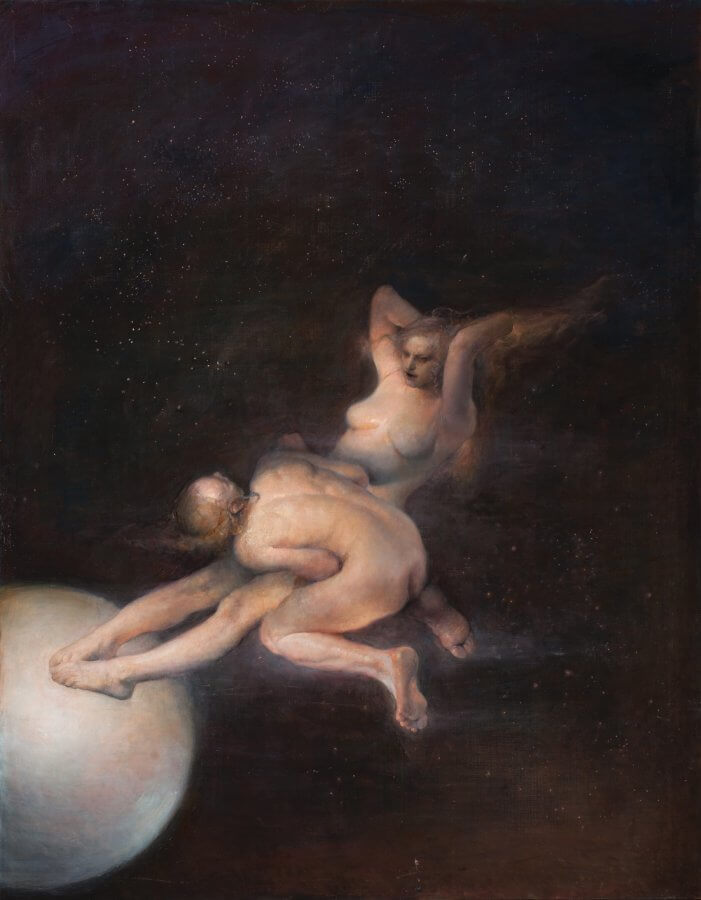
“Love Divided” (2005) by Odd Nerdrum. First version was made in 1968.
From Barren Landcapes to Limbo
In 2002, Odd Nerdrum immigrated to Iceland and settled with his family in the old library in Reykjavik. At this time he had painted barren backgrounds for almost twenty years. Paradoxically, the main production on Iceland belonged to a different world of motifs.
The desire for a reality which placed the human being in the center led to the resurrection of an idea that Nerdrum experimented with as a child when he painted white figures resurrecting on a black background as a response to fever fantasies.
His first void pictures were conceived in his student years, but he would not wholeheartedly embrace this theme until the early 2000s.
“Love Divided” was the first painting in the series of void-pictures that Nerdrum made during his stay in Iceland.
The void paintings represent a further development of the desolated landscape, which was now released from redundant references.
There is no doubt that Iceland has had a big influence on Nerdrum’s development as a painter. Nevertheless, there are aspects with his use of landscape and the void which remain unexplained.
When Nerdrum painted “The Fall,” he had not yet stepped into the wilderness and the production of these years seem to lack the references to the rough territory of Iceland.
It turns out that the first motifs from 1983-84, such as “The Mother,” “The Singers,” and “The Iron Law,” where inspired by photographs of Persian deserts and mountainous landscapes.
The backgrounds for the first apocalyptic pictures are not collected from Iceland, but from Iran.
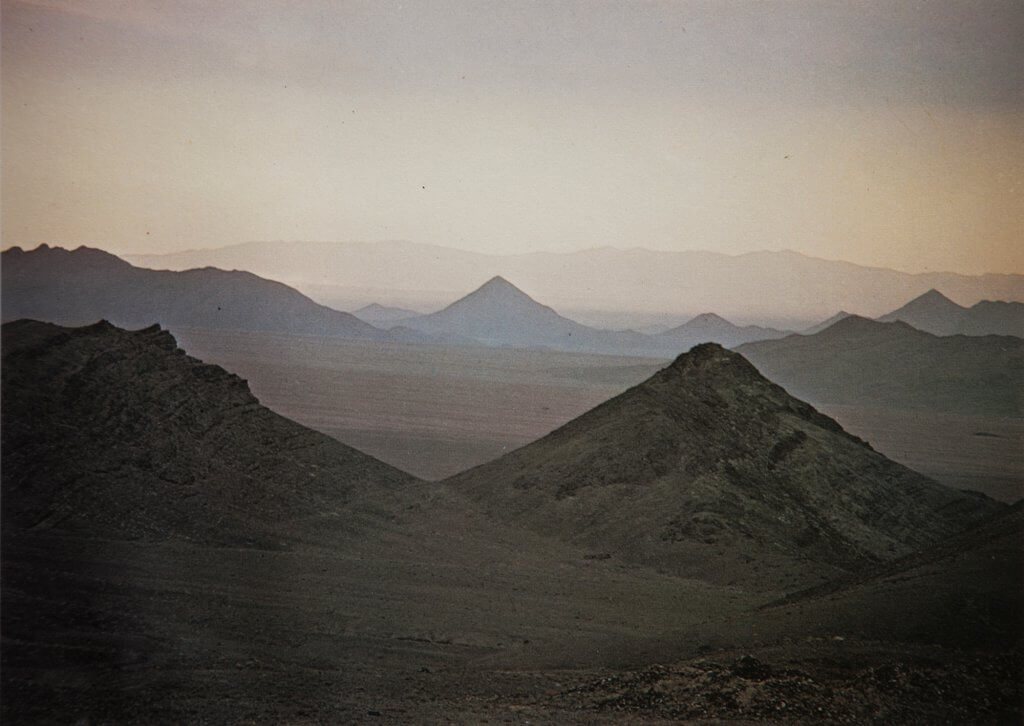
Near Damghan south of the Alburz PHOTO: John Warren
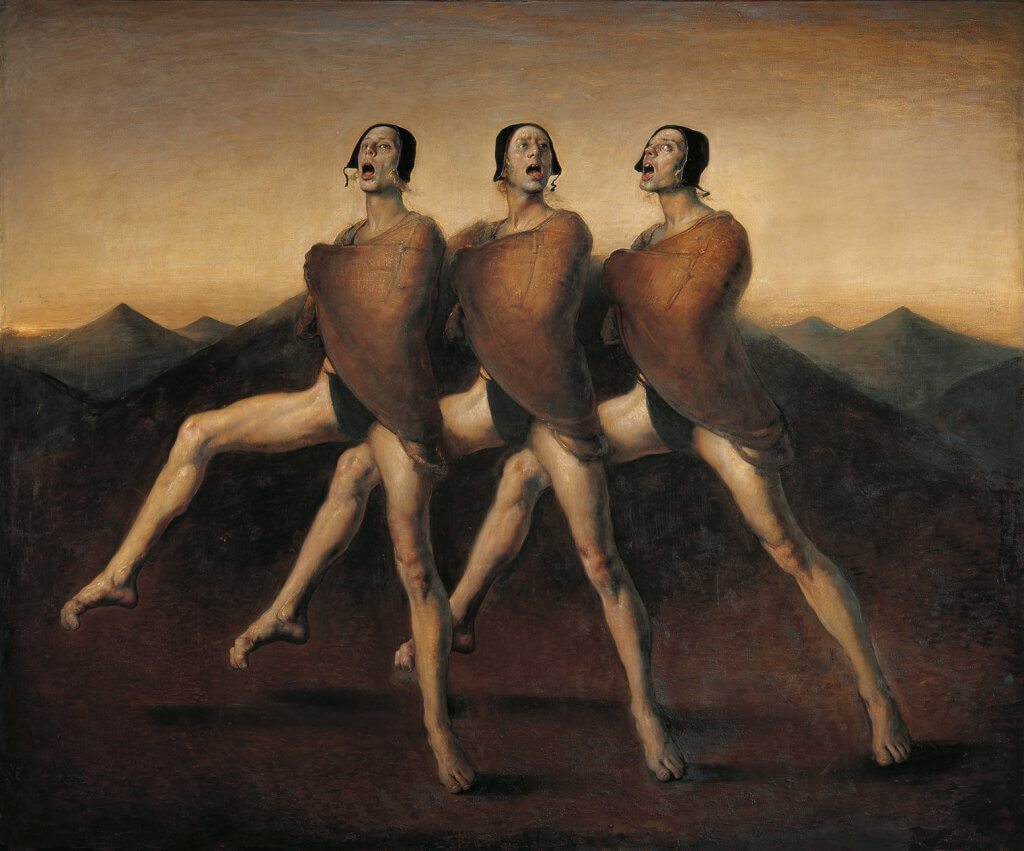
“The Singers” (1984) by Odd Nerdrum
But why the curved horizons with sleeping, barefooted people who live alone in no man’s land? And what about the oval forms, and the people floating around small globes in void?
It is time to leave Iceland and trace the origin of Nerdrum’s universe.
The Source of Nerdrum’s Allegorical Imagery
In Watts Gallery in the English village of Compton, near Guildford in Surrey, hangs a version of the painting that has formed Odd Nerdrum’s apocalyptic motifs more than any other picture.
G. F. Watts’ “Hope” was painted in the same year as Munch’s “The Sick Child” and shows a blindfolded woman seated on top of a globe above the clouds, clinging to the remaining chord of a broken harp.
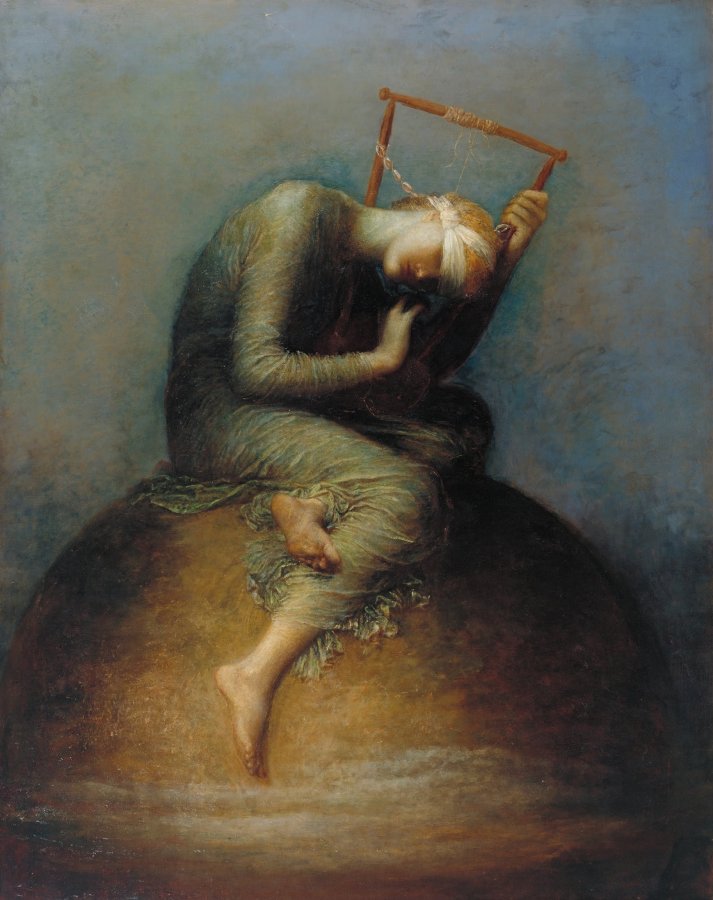
“Hope” (1886) by G.F. Watts
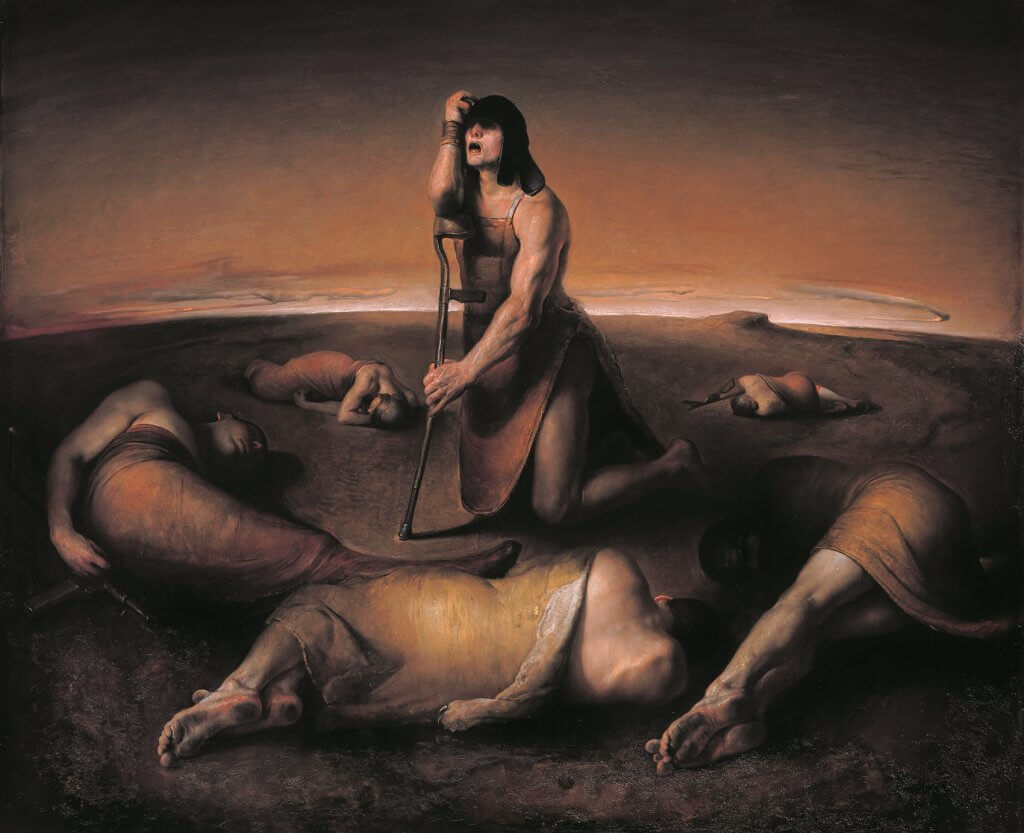
“Night Guard” (1986) by Odd Nerdrum. In the collection of Seven Bridges Foundation in Greenwich, CT.
The centralized figure in Watts’ picture did not only influence the void paintings, but was also the foundation for the figuration in the deserted landscape. The motif has been repeated several times through some of Nerdrum’s most iconic paintings. By removing references from actual surroundings, thus creating a heliocentric perspective, Nerdrum’s compositions became more realistic versions of the “Hope.”
In “The Night Guard,” (above) the sleeping figures make up a circle that echoes the globe from Watts’ painting. Nerdrum has mirrored the posture; the harp has been replaced by a crutch and the watchman is even blindfolded by a leather helmet.
There are striking similarities between Watts and Nerdrum in most of his paintings from the 1980s, including poetic quietness, curved horizons and exalted figures that are looking away from the viewer.
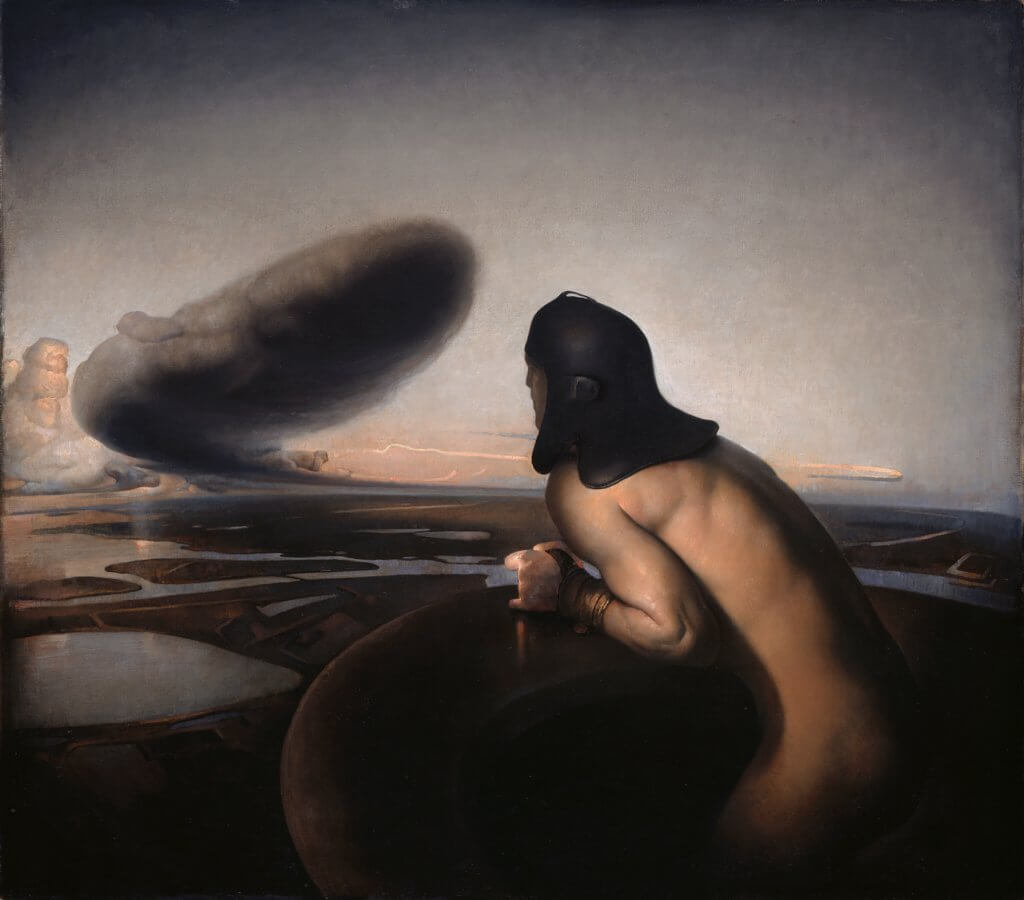
“The Cloud” (1985) by Odd Nerdrum
The English Michelangelo
George Frederic Watts (1817-1904) was often called “The English Michelangelo,” but hardly anyone comes to Compton now to see the works that were once world famous. People draw connections between the London-based painter with the Pre-Raphaelites, although he never belonged to any movement. His attempt to compose in the spirit of Raphael, was given up early on, and he devoted a great part of his life to portrait painting.
When he finished the “Hope,” he had taken the first step into a world where the plot is often related to myths and biblical texts, but also his own ideas. According to Watts, his goal was to bring out the best and the most noble traits in the human being.
The themes of the pictures awaken fundamental questions about life, death, and love, visualized with stylized Phidias figures. Antiquity interested him early on and he abandoned the Royal Academy to study the Parthenon sculptures at the British Museum. The drapery folds on the Greek statues are repeated in many of Watts’ later pieces.
With his own museum in London and a solo exhibition at the Metropolitan Museum in New York in 1884, he reached the climax of his success. But when Impressionism and then later Expressionism came, he wrote prophetically to a friend:
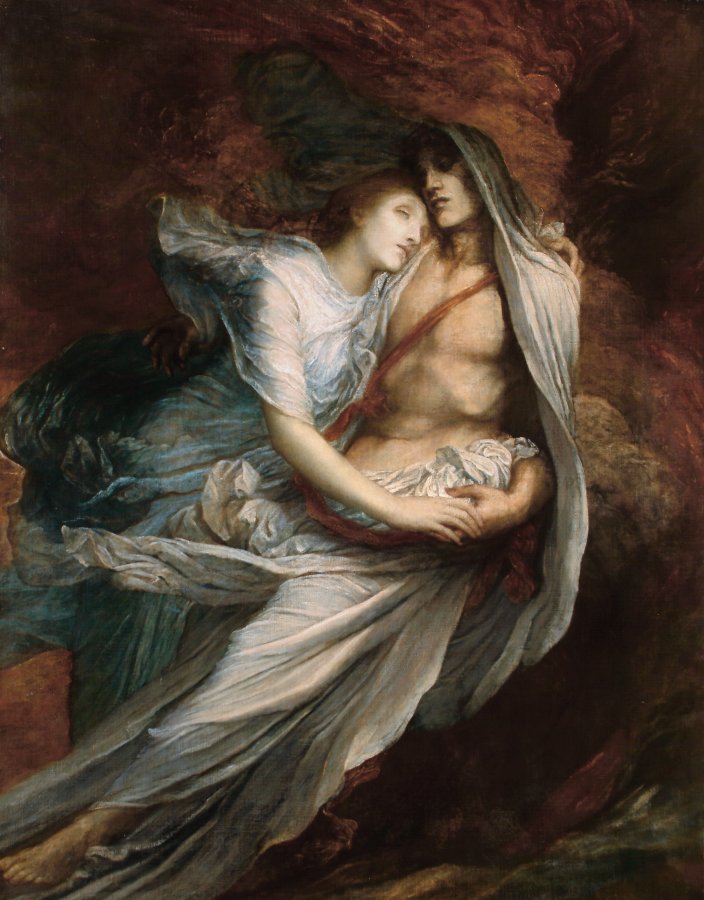
“Paolo and Francesca” (1872-75) by G.F. Watts
It is over… the knowledge is lost. The wave is coming from Paris… Slowly we will be forgotten… — G.F. Watts, 1892
Shortly after, in the year 1904, Watts dies.
Fifty years later, Nerdrum discovers an old reproduction of the “Hope,” which hangs in the stairwell of his grandfather’s home. The collection of paintings and artifacts of Supreme Court Attorney Odd Nerdrum (senior) were plundered by the National Socialists during the war, but the reproduction of Watts’ painting was left in piece, after everything else was confiscated.
Fifteen years old, he dedicates a poem to the painting, and makes variations of the motif on brown colored paper. In 1967, he finally sees the painting at Tate Britain, London.
It was a shock for him seeing it real life,” Öde Nerdrum explains in The Hunt of Odd Nerdrum, “because he had always perceived it in sepia colours, close to da Vinci’s drawing of St. Anne. According to my father, this motif was always meant to be sepia colored and early on he thought about making his own sepia color version, but as we can see here,” he says and points at The Nightguard (1986) and Memory Hall (1985) from a book, “he has already made many sepia colored verions.”
The Conclusion
Nerdrum’s post-apocalyptic paintings are undoubtedly influenced by Watts and “Hope” was his primary source of inspiration over a long period of time. Isolated human beings over the clouds, on a spherical foundation, is an attribute you might as well grant several of Nerdrum’s motifs. With Hertervig’s perception of form, Caravaggio’s realism and Watts’ exaltation of man, the painterly influences unite in the Icelandic landscape.
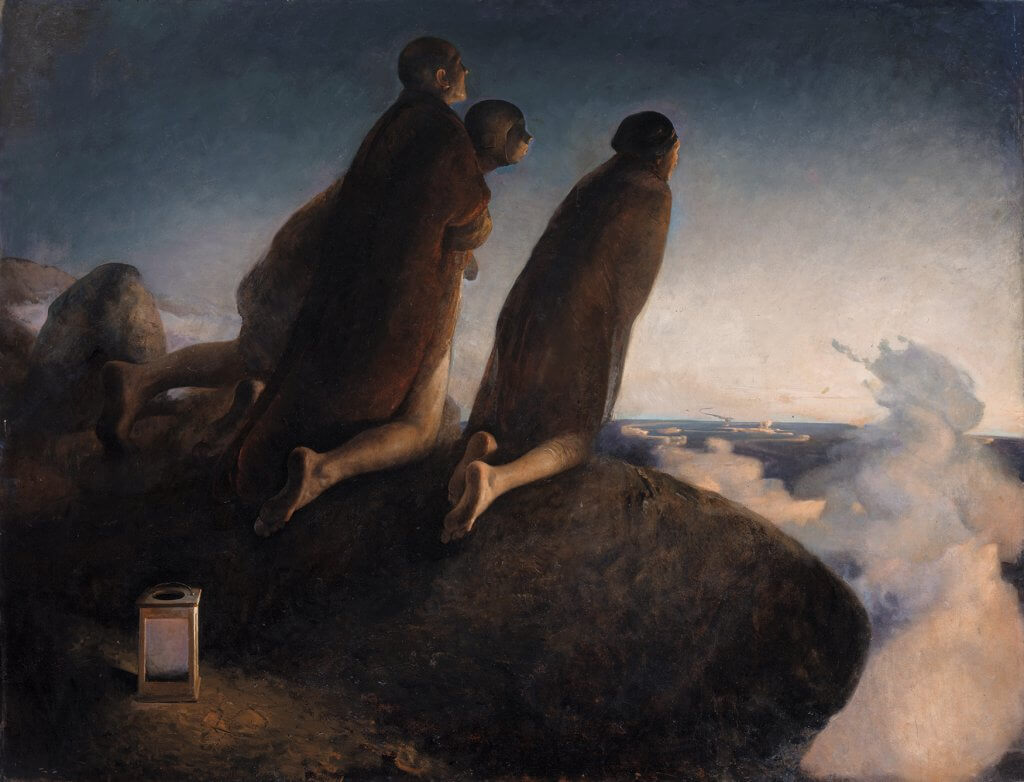
“The Ultimate Sight” (1983) by Odd Nerdrum: a synthesis of Hertervig, Caravaggio, Watts and the barren landscape.
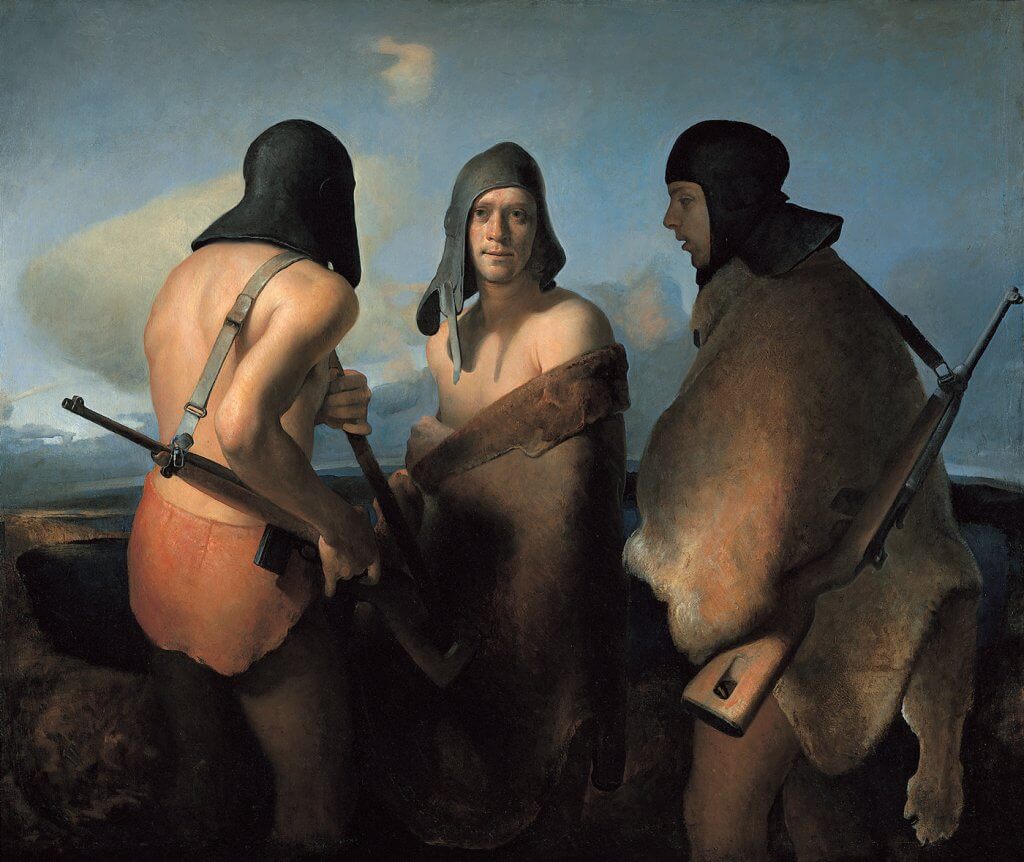
“The Waterprotectors” (1986) by Odd Nerdrum.
Nevertheless, there are some crucial differences between Nerdrum and Watts. While the British painter has monotonous color tones, Nerdrum’s rendering of skin is more varied. Moreover, the lack of eye contact in Watts’ paintings places them in a purely aesthetic realm. Almost all of his paintings consist of closed eyes or averted faces.
The realistic atmosphere in Nerdrum’s paintings gives the symbolic content more density. The human beings react to each other and are depicted as real people with real skin.
The direct contact with the viewer is neither typical with Watts or any other painter we have investigated so far.
In order to get to the source of his painterly development we must extend our trip to Holland.
This is the third in a series of six articles based on “The Hunt of Odd Nerdrum” (2018) which is available for streaming at vimeo.com/ondemand/oddnerdrum.
Members of WWK get 25% off any purchase. Send an e-mail to nerdrum.bork@gmail.com for more information.
The Hunt of Odd Nerdrum
Deciding to track down Odd Nerdrum’s sources of inspiration, his former pupil Jan-Ove Tuv and his son Öde go on a world tour, visiting the museums and people that crossed paths with the painter in his pursuit of the immortal masterpiece.
Genre: Documentary Duration: 4 h 26 min
Subtitles: English, Spanish and Chinese
Published on Wednesday, June 27th, 2018
